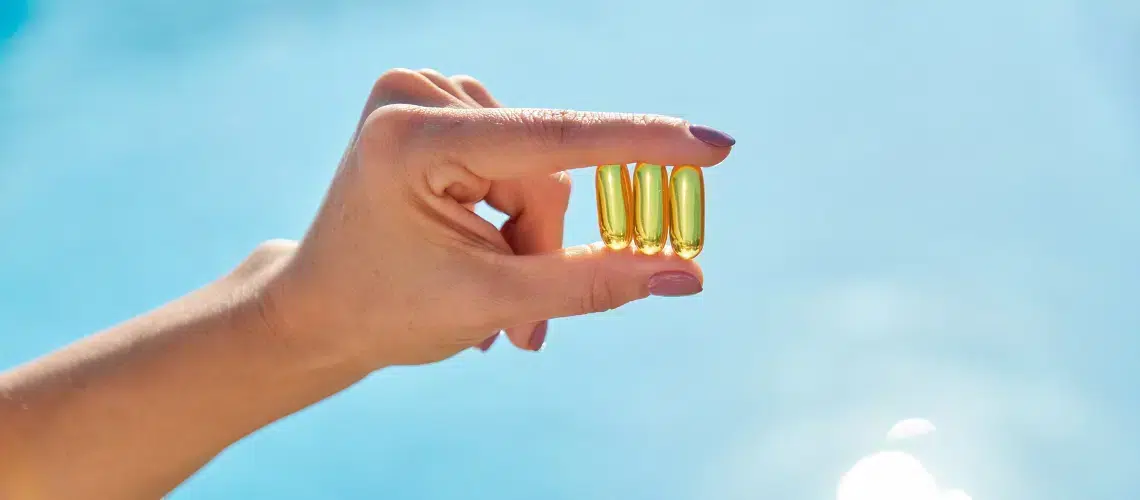Vitamin D is an essential nutrient that plays an important role in bone formation, muscle health, and immune system function, as well as other processes in the body. When looking into products or supplements containing vitamin D, you may come across the term vitamin D3. This may bring the following question to your mind; what is the difference between the two and what is the most beneficial for me? Learn more about the difference between vitamin D and D3 in this blog.
What is vitamin D?
Vitamin D is a fat-soluble vitamin, meaning the body can store it for future use. In addition to obtaining vitamin D through food or supplements, the body can also make its own vitamin D with the help of sunlight. There are two types of vitamin D found in food; ergocalciferol (vitamin D2) and cholecalciferol (vitamin D3) (Harvard Health, 2023). Vitamin D3 can also be produced by the skin when it is exposed to the sun’s ultraviolet B (UVB) rays.
What is the difference between vitamin D and vitamin D3?
Collectively, both vitamin D2 and D3 are referred to as “vitamin D”. This means there is no difference between vitamin D and vitamin D3. However, there are differences between vitamin D2 and D3:
- Vitamin D2: Also known as ergocalciferol, this vitamin is found in plant foods, particularly mushrooms that have been exposed to UV light. Vitamin D2 is cheaper to produce than vitamin D3 and is often used to fortify products such as milk, cereals, and orange juice.
- Vitamin D3: This form of vitamin D is known as cholecalciferol, and is the type of vitamin D formed on the skin of humans and animals when exposed to the sun. Vitamin D3 is found in animal products, such as mackerel, salmon, trout, tuna, beef liver, and eggs.
Supplements and fortified foods may use either vitamin D2 or vitamin D3. Both forms of vitamin D are active and can be used by our bodies. However, vitamin D3 has been found to be more effective at raising the blood concentration of vitamin D in humans and sustaining those levels for longer (Tripkovic et al., 2012). As such, some experts prefer vitamin D3 over D2 as more foods naturally contain this form of the vitamin and it is naturally produced in the body.
Symptoms of vitamin D deficiency
A vitamin D deficiency usually has few to no noticeable symptoms initially, or the symptoms may be confused with other health problems. Severe symptoms may only appear when a vitamin D deficiency has existed for a long period of time. Symptoms of vitamin D deficiency can include:
- Muscle weakness
- Bone fractures
- Bone or muscle pain
- Fatigue
- Low mood
- Depression
- Getting sick more often
Source: Cleveland Clinic, 2022
What is the best source of vitamin D?
The sun is the best natural source of vitamin D. Through regular sunlight exposure, our bodies can produce adequate vitamin D on their own. However, it can be difficult to get adequate vitamin D from the sun if you live in an area with little sunlight, spend limited time outdoors, often wear clothes that cover most of the skin, or have a darker complexion (Cleveland Clinic, 2022). Besides the sun, vitamin D can be obtained through food or supplements.
How much vitamin D do you need per day?
The amount of vitamin D you need daily depends on a number of factors, including age, skin colour, and other health conditions. An intake of 10 to 20 micrograms per day is enough for most adults, and it is advised not to exceed more than 100 micrograms per day (NHS, 2020). Besides vitamin D intake, the vitamin D level in the blood is also important. The reference range for a normal vitamin D level can range depending on the test and laboratory used, but the following general reference ranges in adults apply:
- Deficiency < 30 nmol/l
- Insufficient supply 25 – 75 nmol/l
- Sufficient supply > 75 nmol/l
- Toxicity > 250 nmol/l
Source: Amrein et al., 2020
When do you need vitamin D supplements?
To know if you need vitamin D supplements, you should first check and see if the vitamin D levels in your blood are low or not. This can be done at your GP or using a home blood test. Homed-IQ’s Vitamin D Test is a home vitamin test that involves taking a blood sample from home before sending the sample to a laboratory for analysis.
If your vitamin D level is low, you can take steps to increase it through sun exposure and including foods that contain vitamin D in your diet. In individuals where it is difficult to make these changes or those with increased vitamin D needs, supplements may be recommended. Always speak to your doctor before taking any supplements to ensure you are taking the correct dose. Although supplements can be a useful tool for increasing vitamin D, using them at too high a dose or without a medical need can be harmful to your health.
Would you like to test other vitamins in addition to vitamin D? Homed-IQ’s Vitamin Deficiency Test checks the level of folic acid, vitamin B12, and vitamin D in your blood from home.
-

Vitamin Deficiency Test
€65,00
References
Amrein, K., Scherkl, M., Hoffmann, M., Neuwersch-Sommeregger, S., Köstenberger, M., Berisha, A. T., Martucci, G., Pilz, S., & Malle, O. (2020). Vitamin D deficiency 2.0: an update on the current status worldwide. European Journal of Clinical Nutrition, 74(11), 1498–1513. https://doi.org/10.1038/s41430-020-0558-y
Cleveland Clinic. (2022, August 2). Vitamin D Deficiency: Causes, Symptoms & Treatment. https://my.clevelandclinic.org/health/diseases/15050-vitamin-d-vitamin-d-deficiency
Harvard Health. (2023, March 7). Vitamin D. The Nutrition Source. https://www.hsph.harvard.edu/nutritionsource/vitamin-d/#:~:text=Vitamin%20D2%20is%20made%20from,is%20found%20in%20animal%20foods.
NHS. (2021, November 19). Vitamin D. nhs.uk. https://www.nhs.uk/conditions/vitamins-and-minerals/vitamin-d/
Tripkovic, L., Lambert, H., Hart, K., Smith, C., Bucca, G., Penson, S., Chope, G. A., Hyppönen, E., Berry, J. L., Vieth, R., & Lanham-New, S. A. (2012). Comparison of vitamin D2 and vitamin D3 supplementation in raising serum 25-hydroxyvitamin D status: a systematic review and meta-analysis. The American Journal of Clinical Nutrition, 95(6), 1357–1364. https://doi.org/10.3945/ajcn.111.031070





